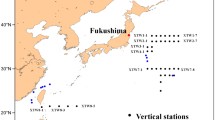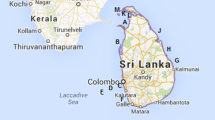Abstract
High concentrations of several radionuclides were reported in the sea near the Fukushima Daiichi Nuclear Power Station (FDNPS) in Japan due to the nuclear accident that occurred on 11 March 2011. The main source of these concentrations was leakage of highly radioactive liquid effluent from a pit in the turbine building near the intake canal of Unit-2 of FDNPS through a crack in the concrete wall. In the immediate vicinity of the plant, seawater concentrations reached 68 MBq m−3 for 134Cs and 137Cs, and exceeded 100 MBq m−3 for 131I in early April 2011. These concentrations began to fall as of 11 April 2011 and, at the end of April, had reached a value close to 0.1 MBq m−3 for 137Cs. Following the nuclear accident, the Tokyo Electric Power Company (TEPCO) had initiated intense monitoring of the environment including the Pacific Ocean. Seawater samples were collected and the concentrations of few radionuclides were measured on a wide spatial and temporal scale. In this study, the measured concentrations of different radionuclides near the south discharge canal of the FDNPS were used to estimate their leakages into the Pacific Ocean. The method is based on estimating the release rates that reproduce the concentration of radionuclides in seawater at a chosen location using a two-dimensional advection–dispersion model in an iterative manner. The radioactive leakages were estimated as 5.68 PBq for 131I, 2.24 PBq for 134Cs and 2.25 PBq for 137Cs. Leakages were also estimated for 99mTc, 136Cs, 140Ba and 140La and they range between 0.02 PBq (99mTc) and 0.53 PBq (140Ba). It was estimated that about 11.28 PBq of radioactivity in total was leaked into the Pacific Ocean from the damaged FDNPS. Out of this, 131I constitutes 50.3 %; 134Cs 20 %; 137Cs 20 %; 140Ba 4.6 %; 136Cs 2.6 %; 140La 2.3 % and 99mTc 0.2 % of the total radioactive leakage. Such quantitative estimates of radioactive leakages are essential prerequisites for short-term and local-scale as well as long-term and large-scale radiological impact assessment of the nuclear accident.










Similar content being viewed by others
References
Aarkrog A (1988) The radiological impact of the Chernobyl debris compared with that from nuclear weapons fallout. J Environ Radioact 6:151–162
Aksoy AO, Guney MS (2010) Experimental determination of three-dimensional dispersivities in homogeneous porous medium. Environ Earth Sci 60:383–393
Bailly du Bois P et al (2012) Estimation of marine source-term following Fukushima Daiichi accident. J Environ Radioact 114:2–9
Bobba AG, Singh VP, Bengtsson L (2000) Application of environmental models to different hydrological systems. Ecol Model 125:15–49
Bowen VT et al (1980) Fallout radionuclides in the Pacific Ocean: Vertical and horizontal distributions, largely from GEOSECS stations. Earth Planet Sci Lett 49:411–434
Buesseler KO, Livingston HD, Casso SA (1991) Mixing between oxic and anoxic waters of the Black Sea as traced by Chernobyl cesium isotopes. Deep-Sea Res 38:S725–S745
Buesseler KO et al (2012) Fukushima-derived radionuclides in the ocean and biota off Japan. PNAS 109:5984–5988
Chino M et al (2011) Preliminary estimation of release amount of 131I and 137Cs accidentally discharged from the Fukushima Daiichi nuclear power plant into the atmosphere. J Nucl Sci Technol 48:1129–1134
Estournel C et al (2012) Assessment of the amount of cesium-137 released into the Pacific Ocean after the Fukushima accident and analysis of its dispersion in Japanese coastal waters. J Geophys Res 117:C11014. doi:10.1029/2012JC007933
Gonzalez-Fernandez D, Garrido-Perez MC, Casas-Ruiz M, Barbero L, Nebot-Sanz E (2012) Radiological risk assessment of naturally occurring radioactive materials in marine sediments and its application in industrialized coastal areas: Bay of Algeciras, Spain. Environ Earth Sci 66:1175–1181
IAEA (1985) Hydrological Dispersion of Radioactive Material in Relation to Nuclear Power Plant Siting. Safety Guide Seires 50-SG-S6. International Atomic Energy Agency, Vienna
IAEA (2001) Generic Models for use in assessing the Impact of Discharges of Radioactive Substances to the Environment. Safety Reports Series No 19. International Atomic Energy Agency, Vienna
IAEA (2011) Web Site: http://www.iaea.org/newscenter/news. Vienna: International Atomic Energy Agency
Inoue M et al (2012) Low levels of 134Cs and 137Cs in surface seawaters around the Japanese Archipelago after the Fukushima Daiichi Nuclear Power Plant accident in 2011. Geochem J 46:311–320
IRSN (2011) Impact on the Marine Environment of Radioactive Releases following the Nuclear Accident at Fukushima Daiichi. Information Note dated 13 May 2011. France: Institute for Radiological Protection and Nuclear Safety
MEXT (2011) Web Site: http://www.mext.go.jp/en/contents. Ministry of Education, Culture, Sports, Science and Technology, Japan
Monte L, Perianez R, Boyer P, Smith JT, Brittain JE (2009) The role of physical processes controlling the behaviour of radionuclide contaminants in the aquatic environment: a review of state-of-the-art modelling approaches. J Environ Radioact 100:779–784
Morino Y, Ohara T, Nishizawa M (2011) Atmospheric behavior, deposition, and budget of radioactive materials from the Fukushima Daiichi nuclear power plant in March 2011. Geophys Res Lett 38:L00G11. doi:10.1029/2011GL048689
Nakanishi T et al (2011) Vertical distributions of 99Tc and 99Tc/137Cs activity ratio in the coastal water off Aomori, Japan. J Environ Radioact 102:774–779
NISA (2011) Web Site: http://www.nisa.meti.go.jp/english/files. Nuclear and Industrial Safety Agency, Japan
Schreiber DL (1978) Liquid Pathway Generic Study—Impacts of Accidental Radioactive Releases to the Hydrosphere from Floating and Land-Based Nuclear Power Plants. Rep No NUREG-0440. Washington: US Nuclear Regulatory Commission
Shimizu Y, Yasuda I, Ito S (2001) Distribution and circulation of the coastal Oyashio intrusion. J Phys Oceanogr 31:1561–1578
Stewart RH (2006) Introduction to Physical Oceanography. Texas A&M University
Stohl A et al (2012) Xenon-133 and caesium-137 releases into the atmosphere from the Fukushima Daiichi nuclear power plant: determination of the source term, atmospheric dispersion, and deposition. Atmos Chem Phys 12:2313–2343
Tagami K et al (2011) Specific activity and activity ratios of radionuclides in soil collected about 20 km from the Fukushima Daiichi Nuclear Power Plant: Radionuclide release to the south and southwest. Sci Total Environ 409:4885–4888
TEPCO (2011) Web Site: http://www.tepco.co.jp/en/press/corp-com/release. Tokyo Electrical Power Company, Japan
TEPCO (2012) Web Site: http://www.tepco.co.jp/en/press/corp-com/release. Tokyo Electrical Power Company, Japan
Thiessen KM, Thorne MC, Maul PR, Prohl G, Wheater HS (1999) Modelling radionuclide distribution and transport in the environment. Environ Pollut 100:151–177
Tsumune D et al (2012) Distribution of oceanic 137Cs from the Fukushima Daiichi Nuclear Power Plant simulated numerically by a regional ocean model. J Environ Radioact 111:100–108
Valkovic V (2000) Radioactivity in the environment. Elsevier, Amsterdam
Wakeford R (2011) And now, Fukushima. Editorial. J Radiol Prot 31:167–176
Whicker FW, Shaw G, Voigt G, Holm E (1999) Radioactive contamination: state of the science and its application to predictive models. Environ Pollut 100:133–149
Yadav RR, Jaiswal DK, Yadav HK, Gulrana (2012) Three-dimensional temporally dependent dispersion through porous media: analytical solution. Environ Earth Sci 65:849–859
Yadigaroglu G, Munera HA (1987) Transport of pollutants: summary review of physical and dispersion models. Nucl Technol 77:125–149
Yanagimoto D, Taira K (2003) Current measurements of the Japan Sea proper water and the intermediate water by ALACE floats. J Oceanogr 59:359–368
Yasuda I (2003) Hydrographic structure and variability in the Kuroshio-Oyahio transition area. J Oceanogr 59:389–402
Yasunari TJ et al (2011) Cesium-137 deposition and contamination of Japanese soils due to the Fukushima nuclear accident. Proc Natl Acad Sci USA 108:19447–19448
Acknowledgments
Authors express sincere thanks to TEPCO, MEXT and NISA for making available large amounts of data pertaining to the FDNPS nuclear accident in the public domain ever since the occurrence of the accident. Thanks are also due to Dr. D. N. Sharma; Director; Health, Safety and Environment Group; Bhabha Atomic Research Centre for his keen interest in the study.
Author information
Authors and Affiliations
Corresponding author
Electronic supplementary material
Below is the link to the electronic supplementary material.
Rights and permissions
About this article
Cite this article
Nair, R.N., Sunny, F., Chopra, M. et al. Estimation of radioactive leakages into the Pacific Ocean due to Fukushima nuclear accident. Environ Earth Sci 71, 1007–1019 (2014). https://doi.org/10.1007/s12665-013-2501-1
Received:
Accepted:
Published:
Issue Date:
DOI: https://doi.org/10.1007/s12665-013-2501-1




